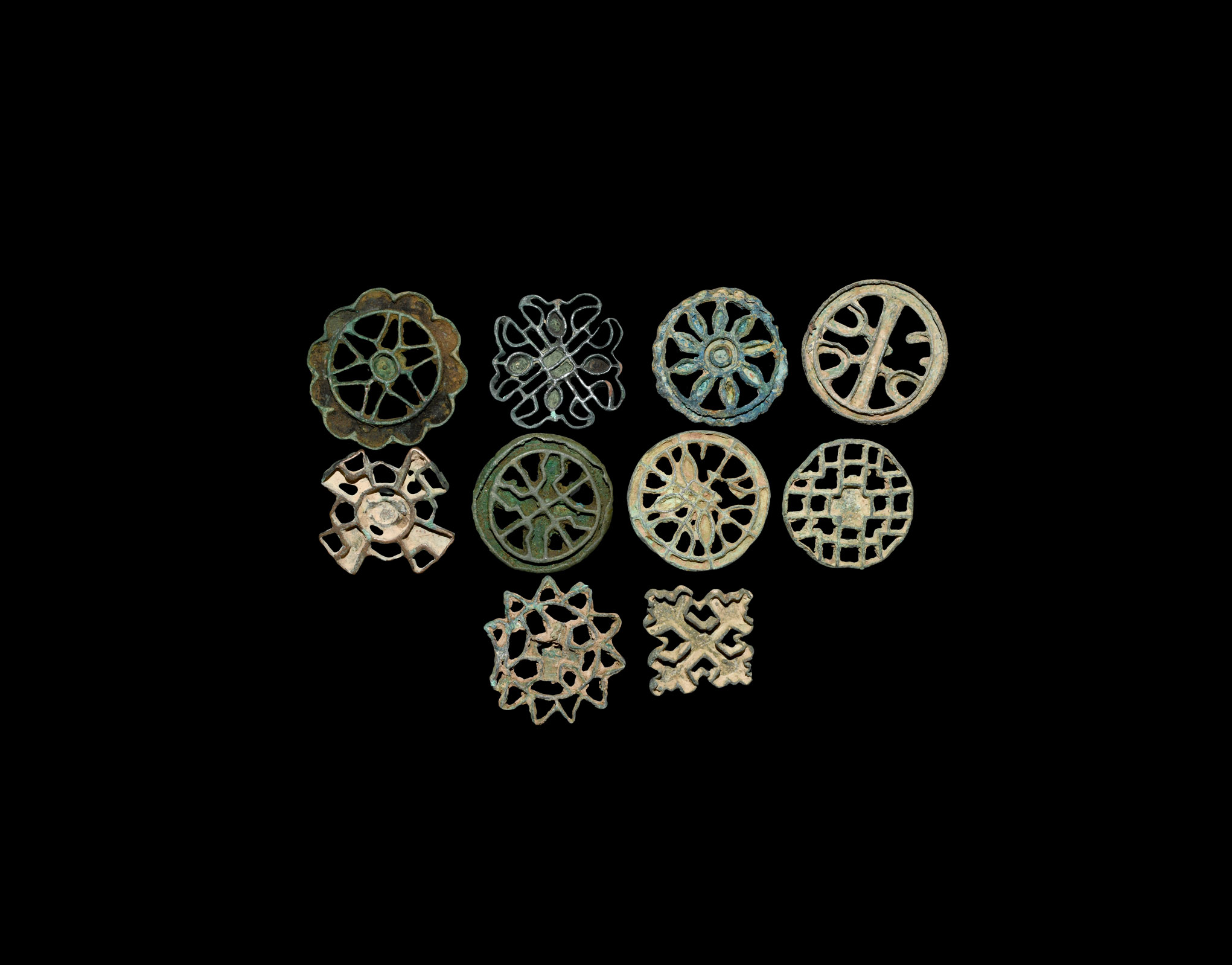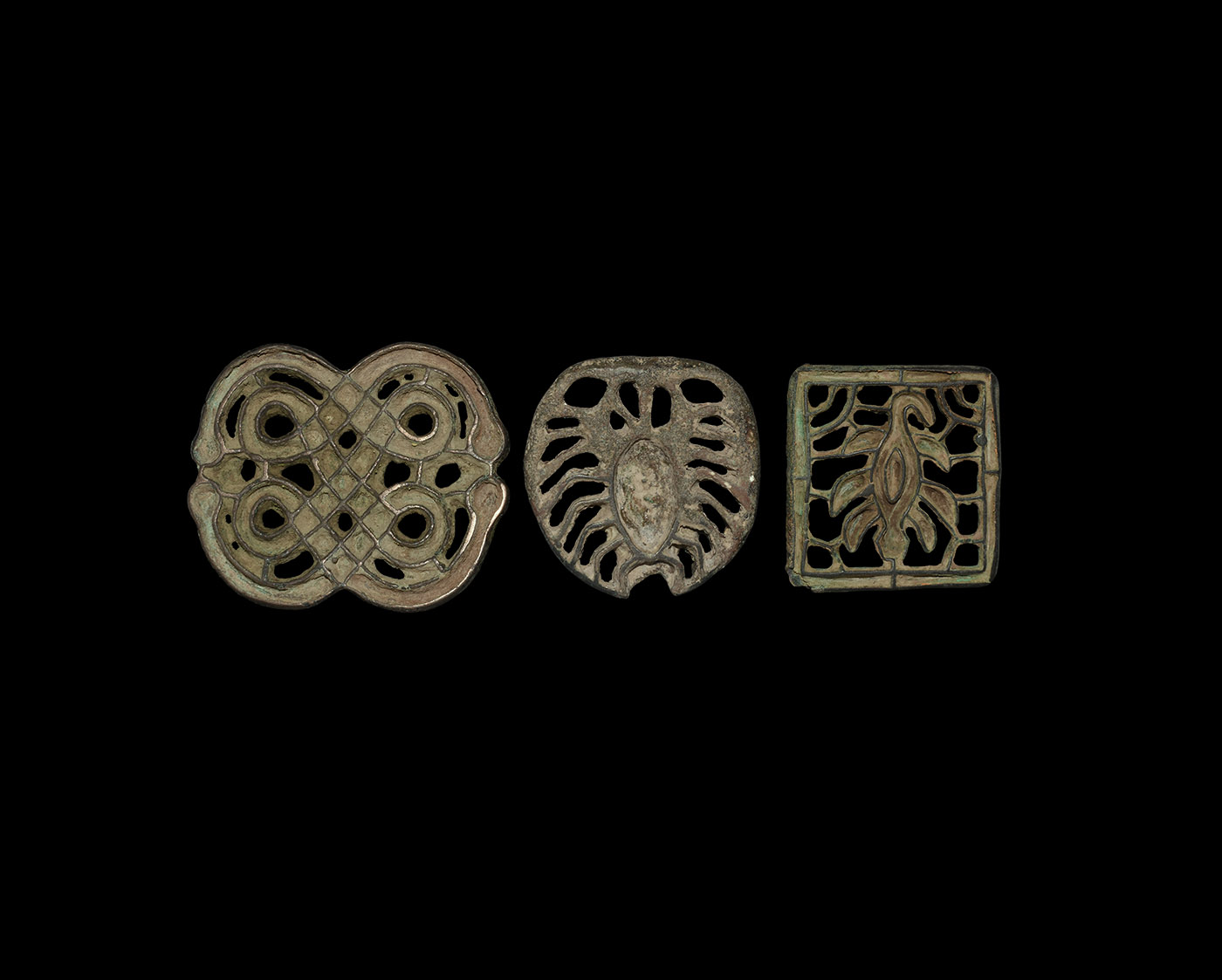Indus Valley Stamp Seal Collection Late 3rd-2nd millennium BC A mixed group of ten bronze seals including eight accompanied by typed and signed notes by the late W.G. Lambert, Professor of Assyriology at the University of Birmingham, 1970-1993, which states: R-700) 'A Stamp Seal of Bronze, 29 x 28 x 11 mm. This is roughly square, with flat face and flat back, on which is mounted a broad handle of inverted V-shape. The design on the face consists of a series of L-shape of increasing size from the corners, leaving a simple cross in the middle, which is blocked at one side of the centre. The design is compartmented. This comes from west central Asia and dates to c. 2300-2000 B.C. It is a rare type and save for slight damage to the corners is in very good condition.'; T-727) 'A Stamp Seal of Bronze, 49 x 48 x 19 mm. This is very roughly square, with flat face and flat back, on which is mounted a handle of inverted V-shape.The design , which is both compartmented and open-work, consists of a central Greek cross joined to the outer rim by struts from the middle of the end of each arm, and the remaining space in each quarter so created is filled with two crescent shapes. This comes from west central Asia and dates to c. 2300-2000 B.C. The metal has been conserved, and the piece is in very good condition.'; T-663) 'A Stamp Seal of Bronze, 49 x 48 x 19 mm. This is round, with flat face and flat back on which is mounted a handle of inverted V-shape. The design, which is both compartmented and open-work, consists of a central Greek cross joined by struts from the tips of each bar of the cross to a plain outer band. This comes from west central Asia and dates to c. 2300-2000 B.C. There is slight denting of the rim, otherwise it is in good condition, and a nice example of its kind.'; T-238) 'A Stamp Seal of Bronze, 36.5 x 36 x 14.5 mm. This is round with flat face and flat back on which is mounted a handle of inverted U-shape. The design, which is both compartmented and open-work, shows a rosette with six petals within a plain outer band. The design is reinforced on the back with hatching around the edge and the marking of the tips of the petals. This comes from west central Asia and dates to c. 2300-2000 B.C. It is in good condition, and is a nice example of its kind.'; U-338) 'A Stamp Seal of Bronze, 35 x 38 x 14 mm. This bears the shape of the design, with flat face and flat back, on which is mounted a handle of inverted U-shape. The design consists of a central quadrate cross, each arm of which extends and divides into two curving bands which meet those of the next arm,etc. This comes from west central Asia and dates to c. 2300-2000 B.C. It is bent and the outer rim is damaged in places and the handle is worn, but the piece conveys very well its original form and design. The metal appears to be sound.'; D-16) 'A Stamp Seal of Bronze, 44 x 43 x 12 mm. This is a compartmented and open-work seal, with flat face and flat back on which a loop of sheet metal is mounted. The shape is roughly square, with a Greek cross set diagonally in the middle, inside a larger Greek cross with one outer corner of each arm extending both sideways for a short distance and outwards, where it becomes a sweeping extension of the next outer corner. This comes from west central Asia and dates to c. 2300-2000 B.C. It is in fair condition: the loop is broken, and the whole object a little bent.'; V-401) 'A Stamp Seal of Bronze, 34 x 34 x 11 mm. This is roughly square, with flat face and flat back, on which is a handle pierced on one side only with raised lines and consists of a quadrate cross with circle inside it, joined to the outer rim by a strut from the middle of each end of the cross. Each corner is then filled with two crescents, one inside the other. This comes from west central Asia and dates to c. 2300-2000 B.C. It is in good condition and is one of the rarer types.'; U-69) 'A Stamp Seal of Bronze, 48 x 44 x 16 mm. This is roughly oblong, with straight sh
Indus Valley Stamp Seal Collection Late 3rd-2nd millennium BC A mixed group of ten bronze seals including eight accompanied by typed and signed notes by the late W.G. Lambert, Professor of Assyriology at the University of Birmingham, 1970-1993, which states: R-700) 'A Stamp Seal of Bronze, 29 x 28 x 11 mm. This is roughly square, with flat face and flat back, on which is mounted a broad handle of inverted V-shape. The design on the face consists of a series of L-shape of increasing size from the corners, leaving a simple cross in the middle, which is blocked at one side of the centre. The design is compartmented. This comes from west central Asia and dates to c. 2300-2000 B.C. It is a rare type and save for slight damage to the corners is in very good condition.'; T-727) 'A Stamp Seal of Bronze, 49 x 48 x 19 mm. This is very roughly square, with flat face and flat back, on which is mounted a handle of inverted V-shape.The design , which is both compartmented and open-work, consists of a central Greek cross joined to the outer rim by struts from the middle of the end of each arm, and the remaining space in each quarter so created is filled with two crescent shapes. This comes from west central Asia and dates to c. 2300-2000 B.C. The metal has been conserved, and the piece is in very good condition.'; T-663) 'A Stamp Seal of Bronze, 49 x 48 x 19 mm. This is round, with flat face and flat back on which is mounted a handle of inverted V-shape. The design, which is both compartmented and open-work, consists of a central Greek cross joined by struts from the tips of each bar of the cross to a plain outer band. This comes from west central Asia and dates to c. 2300-2000 B.C. There is slight denting of the rim, otherwise it is in good condition, and a nice example of its kind.'; T-238) 'A Stamp Seal of Bronze, 36.5 x 36 x 14.5 mm. This is round with flat face and flat back on which is mounted a handle of inverted U-shape. The design, which is both compartmented and open-work, shows a rosette with six petals within a plain outer band. The design is reinforced on the back with hatching around the edge and the marking of the tips of the petals. This comes from west central Asia and dates to c. 2300-2000 B.C. It is in good condition, and is a nice example of its kind.'; U-338) 'A Stamp Seal of Bronze, 35 x 38 x 14 mm. This bears the shape of the design, with flat face and flat back, on which is mounted a handle of inverted U-shape. The design consists of a central quadrate cross, each arm of which extends and divides into two curving bands which meet those of the next arm,etc. This comes from west central Asia and dates to c. 2300-2000 B.C. It is bent and the outer rim is damaged in places and the handle is worn, but the piece conveys very well its original form and design. The metal appears to be sound.'; D-16) 'A Stamp Seal of Bronze, 44 x 43 x 12 mm. This is a compartmented and open-work seal, with flat face and flat back on which a loop of sheet metal is mounted. The shape is roughly square, with a Greek cross set diagonally in the middle, inside a larger Greek cross with one outer corner of each arm extending both sideways for a short distance and outwards, where it becomes a sweeping extension of the next outer corner. This comes from west central Asia and dates to c. 2300-2000 B.C. It is in fair condition: the loop is broken, and the whole object a little bent.'; V-401) 'A Stamp Seal of Bronze, 34 x 34 x 11 mm. This is roughly square, with flat face and flat back, on which is a handle pierced on one side only with raised lines and consists of a quadrate cross with circle inside it, joined to the outer rim by a strut from the middle of each end of the cross. Each corner is then filled with two crescents, one inside the other. This comes from west central Asia and dates to c. 2300-2000 B.C. It is in good condition and is one of the rarer types.'; U-69) 'A Stamp Seal of Bronze, 48 x 44 x 16 mm. This is roughly oblong, with straight sh









.jpg)





Try LotSearch and its premium features for 7 days - without any costs!
Be notified automatically about new items in upcoming auctions.
Create an alert